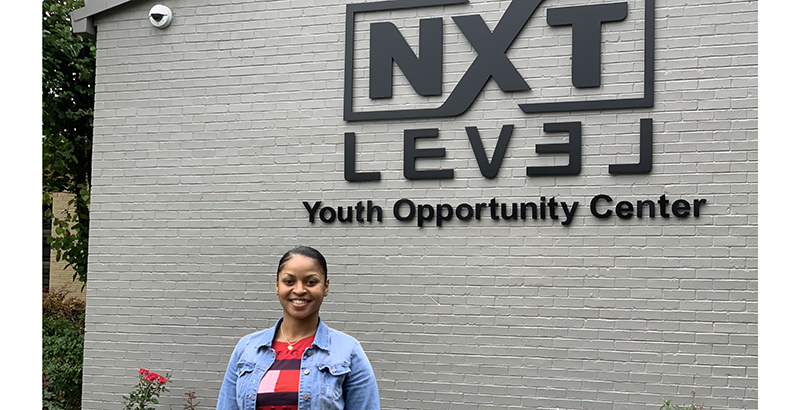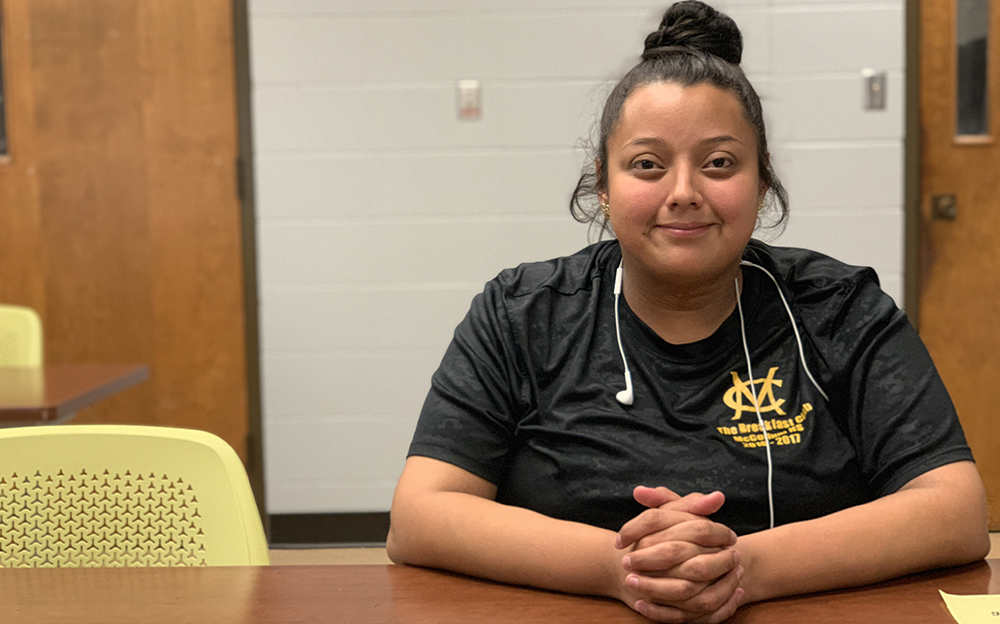4.5 Million Young People Nationwide Are Not Working or in School. How Cities Are Working to Get Them Back on Track — & Avoid the School-to-Prison Pipeline

Updated Aug. 15
For Dionna Camino, it was caring for her terminally ill father. For Shelby Morales, it was an unexpected pregnancy at age 14. For both, it was too much responsibility too soon that knocked them off the tightrope of getting through high school and college to land a good-paying job. Now, they are among the estimated 4.5 million so-called opportunity youth nationwide — 16- to 24-year-olds who are neither in school nor working — struggling to put their lives back together.
Researchers say there are around 75,000 disconnected youth in Los Angeles; 43,000 in Philadelphia; 36,500 in Baltimore; and 35,000 in San Antonio’s Bexar County, where Camino and Morales live. Disengaged from both education and the labor force, these young people are particularly vulnerable to exploitation and abuse, too often finding themselves in the school-to-prison pipeline.
How they got there is a question that has no easy answer, said Steven Hussain, former chief mission services officer of Goodwill San Antonio. Some are homeless or have young children. Maybe they dropped out of high school, have criminal records or are on probation. But some have high school diplomas and even some college coursework. Opportunity youth don’t fit a profile, he said: “It’s usually a mix of things.”
For most opportunity youth, it isn’t a defined set of missteps that apply to certain, exceptionally troubled, kids. It’s really more the opposite: a churning sea of relentless waves and undertows pushing them under and dragging them in all directions.
From their precarious position treading water, they can look up and see the school-to-success high wire — options and resources available to teens that will guide them toward becoming financially, emotionally, socially secure adults. They just don’t know how to climb back on.
In San Antonio, which makes up the vast majority of Bexar County, the Department of Human Services, Goodwill and Communities in Schools opened Nxt Level, the state’s first comprehensive youth re-engagement center, in February. It is specifically designed to help undereducated young people who are disengaged from societal support systems regain their footing. Camino and Morales are just two of the opportunity youth hoping Nxt Level can help them find their way back.
Least likely to end up here
Growing up, Camino, a 24-year-old with a wide grin and expressive eyes, never thought she would need a place like Nxt Level.
“I was that student that they were like, ‘We don’t have to worry about her,’” Camino said, remembering how her teachers and parents talked about her.
She’s smart. She played basketball and wanted to play in college. But during her junior year, her dad was diagnosed with cancer. She was his only child, and her parents were divorced. In her senior year, his condition deteriorated, and she had to start making decisions. Before, she’d just been doing the next thing: taking the next class, winning the next game. Suddenly, there were diverging options.
Camino was given power of attorney for her father. She decided to wait on college, knowing she would have a lot of responsibility at home. She could always go back to school, she figured, “But a father I can’t replace.”
Camino cared for him until he died. She was 21, working at a fast-food restaurant to pay the bills, in a stable relationship. However, she didn’t have health insurance, and without it, she couldn’t afford birth control. By the time college application time rolled around, she and her longtime boyfriend were about to become parents.
“I have a home. I have a car. I have a decent job,” she remembered thinking. “I really want to get into school, but giving this child a chance is maybe what I need to do.”
Still, Camino wanted to do more than just flip burgers, and she decided to become a registered nurse. After her daughter’s first birthday, she was preparing to enroll in a program when she and her boyfriend got into an argument. As they quarreled over the pressures of paying bills and raising a child, she shoved him out of the way as she stormed out of the house, and he, in a moment of spite, pressed charges. She went to court and pleaded no contest.
Because it was her first offense, the judge sentenced Camino to anger management and required her to report in at Nxt Level.
Nxt Level, she said, has been a “second chance” — but with her competitive mentality, Camino struggles with her circuitous path and the fact that she’s now years behind her classmates. “You feel,” she said, “like, ‘Am I doing this right?’”
The kids are disengaged
Nxt Level site manager Timothy Pazderka said it’s ironic that people think of opportunity youth as irresponsible or lazy, when it’s actually the magnitude of their responsibilities that blows them off course.
Once they do become disengaged or disconnected, their problems tend to compound. Which is how it came to be that 11.5 percent of the U.S. population ages 16 to 24 became opportunity youth, according to an April 2019 report from Measure of America. This represents a decline of 1.3 million from the height of 14.7 percent disengaged youth in 2010, during the Great Recession. The report credits a growing economy and focus on high school graduation, but it acknowledges that for black teens, the disconnection rate has actually increased. The report calls for “collective efforts tailored especially for those most at risk.”
Gathering data on opportunity youth is both essential and difficult, said Tamar Mendelson, director of the Center for Adolescent Health at the Johns Hopkins Bloomberg School of Public Health. She has studied opportunity youth for various initiatives, including the National League of Cities re-engagement program, where Nxt Level directors have received training.
“A lot of times, cities don’t even know, ‘Who are these youth?’ ‘Where are they?’” Mendelson said. This is in part due to the many ways students become disengaged. She has seen kids cut off from school and work because of homelessness, LGBTQ ostracism, the pressures of single parenting. Some drop out of high school, while others simply drift away after graduation.
San Antonio underwent a harsh awakening when Municipal Court Judge John Bull’s office reported that 30,000 to 35,000 students in Bexar County were disengaged from school and work, around 15 percent of the total age group. That’s on the high end of percentages in other major cities, such as Los Angeles, where the number is around 14 percent. In Philadelphia, Drexel University researchers estimated as many as 1 in 4 students to be disengaged.
Counting opportunity youth is difficult by nature, because they aren’t in the places where they might easily be found. Bull’s office used school district dropout reports, census data and employment statistics to arrive at his estimates. He was motivated, he said, to better understand his own courtroom, because many disengaged young people end up in municipal court for minor offenses. The county caseworkers in Bull’s office are often the first mental health checkpoint the teen defendants have ever encountered.
“They’re just not used to somebody giving them that attention,” he said. A lot of kids just needed someone to talk to, someone who would listen.
Once Bull had his numbers, it was time to figure out how to change them.
Opportunity youth services require quite a bit of tailoring, said Mendelson. Because these kids don’t travel along a standard pathway, each city needs to take a unique approach based on the expressed needs of the people it wants to serve and the assets available in the community.
This usually means more data collection. To learn more about opportunity youth in Baltimore, for example, members of the center, including young people trained as researchers, asked open-ended questions of the kids and their neighbors. Mendelson was stunned by how much hunger played a role. “There’s a lot of food insecurity,” she said. “We really heard some pretty devastating things about the needs.”
She kept this in mind as the Center for Adolescent Health worked with with Baltimore’s Promise, a citywide collaborative; the mayor’s Office of Employment Development; and Baltimore City Public Schools to evaluate their Grads-to-Careers initiative, a job training and support program for high school graduates who disappeared from education and workforce statistics. Food programs would be needed alongside mental health and legal resources. The program would also provide targeted academic remediation, because graduates from local high schools were often several years behind grade level in reading and math.
The Baltimore post-high school re-engagement program is administered through eight sites around the city, each with job training in a different career field.
In San Francisco, Measure of America calculates 42,000 opportunity youth in the metro area, with another local nonprofit putting the number at almost double that. Through a Jobs for the Future grant, in partnership with the Aspen Institute, Bay Area Community Resources launched an Opportunity Works initiative specifically targeting the 16-to-24 population. One of the programs, ReSET, helps students gain up to 80 hours of job and life skills training, along with SAT prep, résumé workshops and other services specific to their goals.
Washington, D.C., Philadelphia and Los Angeles have all opened re-engagement centers that are one-stop shops — what social workers refer to as “single doors” — for mental health resources, help with navigating public services and career counseling. The specifics of each program have evolved as the operators learned about the needs of their city’s particular opportunity youth and identified partners to meet them.
For homeless youth, basic health and sanitation are where it all begins. At DC ReEngagement, a collaboration between the Office of the State Superintendent of Education and the Office of Neighborhood Safety and Engagement that opened in 2014, youth have access to showers, washers and dryers along with clothing and food pantries.
Philadelphia’s re-engagement program, founded in 2008, is operated by the city school district as an alternative school. It offers a Multiple Pathways program for students who need modified schedules and school services. Among those are child care, GED preparation and job training.
The Los Angeles program began in 2012 and has 14 Youth Source centers around the city. In addition to the standard re-engagement services, a partnership with the Los Angeles Unified School District and the City of Los Angeles Economic and Workforce Development Department emphasizes re-enrollment in high school, with LAUSD staff on site to facilitate.
Last year, Bull decided San Antonio needed a re-engagement program of its own.
The city tapped Goodwill San Antonio and Communities in Schools of San Antonio, a dropout-prevention nonprofit, to create a re-engagement program in the Frank Garrett Center, an underutilized city property in the heart of zip code 78207 — one of the poorest in the country.
The city allocated $760,000 to establish and staff the center, and so far, said Rebecca Flores, the City of San Antonio’s education program director, “We are seeing the kids we thought we’d be seeing.” Operations will run about $660,000 in the center’s second year.
Facing a need in the tens of thousands, Hussain said, the temptation is to create a scalable, one-size-fits-all approach. But that’s unlikely to work for young people who have already been thrown off by the factory model of schooling, inflexible work schedules and inadequate wages.
Because of their other programs in the city, Communities in Schools and Goodwill know that Nxt Level is part, but not all, of the solution. Its strength is its ability to tailor services to the needs of each client.
If the pace keeps up, Nxt Level will serve 600 youth by the end of its first year in February 2020, some needing one service, others returning for more. The performance metrics set a goal of 42 percent of clients going on to complete a diploma or GED, with 80 percent still engaged after one year, and Flores predicted Nxt Level will meet or exceed its goals.
So far, court referrals have been the only outreach the center has used. Other clients have come from word of mouth.
“It’s working overnight,” Bull said.
That could change once Bexar County’s 17 school districts hand over their “leaver lists” — rosters of students who left school without explanation during the 2018-19 school year. Districts spend the summer going to door to door figuring out where the students went. Some have transferred or moved, but for those who are not enrolled in school at all, districts have until October to re-enroll the students before they are considered having dropped out. Bexar County districts have agreed to share their final leaver lists with Bull’s court. Nxt Level staff will then begin tracking down those who have fully dropped out of school. With so many school districts, there are lots of cracks to fall through, though, and until now, no single agency could reach across district boundaries to seek the leavers out.
‘Invasive’ care
When new clients come through the door of Nxt Level, they are met with perhaps the most detailed triage they’ve ever encountered, thanks to one of three Communities in Schools coaches on staff. These licensed counselors and social workers take them through an intake process that touches on adverse childhood experiences, mental health, daily routine and whatever else they need to get a full picture of the person’s life.
“It’s pretty invasive,” said Jessica Weaver, executive director of Communities in Schools–San Antonio. “If we don’t understand the whole story, we’re not going to understand where the bumps are going to come from.”
For Morales, the interest the Nxt Level coaches showed in her was a surprise. She was even more surprised by how much she liked it. “Talking to them makes me happy,” she said, smiling.
Like Camino, Morales came to Nxt Level under a court order after she was charged with assaulting an ex-boyfriend, who was also her manager at a fast-food restaurant. She admits she lost her temper when he humiliated her in front of customers.

Also like Camino, Morales is a parent. She has her high school diploma, which she achieved with her daughter in tow the entire time; she got pregnant in eighth grade.
She didn’t think she could ever earn a bachelor’s degree, but then her brother graduated from a four-year college, and that got her thinking. She had worked a brief stint in an entry-level job at the San Antonio Zoo with lots of room to grow … for people with college degrees and relevant work experience. She loved the environment, the passion the people had for their jobs, the stable atmosphere. It was different from what she had experienced in most of the jobs available to her — fast food, primarily. She wants more options like the zoo, or maybe the music industry.
So Morales decided to make the most of her time at Nxt Level to explore those interests and prepare for her next steps.
After meeting with their Communities in Schools coach, the Nxt Level clients work with Goodwill staff to figure out a plan of action. Are there certificate programs, degree pathways or job training to pursue? Do they just need someone to let them in the door for an interview?
In addition to the formal Nxt Level partners, Bull has called on the business community to consider hiring opportunity youth.
“They’ll do their part to get them ready,” Bull said at an event announcing the center to local financial and business leaders, held at the San Antonio Branch of the Federal Reserve Bank. “We need the business community to meet us halfway and give these kids a chance because, I will tell you in my experience as an employer, those have always been the best employees. They’ll work harder and do more for you … They are so smart and so resilient.”
Goodwill staff are always on the lookout for more area employers willing to offer that chance and help the youth plug in. They want business partners to help clients aim higher. Most opportunity youth have already done the fast-food thing, the call center, the car wash. One of the biggest misconceptions about them, Flores said, is that they are cynical and apathetic. On the contrary, she said, most of the clients at Nxt Level have big dreams. They’re relieved to find a path forward, an alternative to the tightrope they fell off.
Despite having gone through rough years in school, abusive relationships, economic hardship and the criminal justice system, Flores said, “they’re not jaded yet.”
That’s why they call them opportunity youth.
Get stories like these delivered straight to your inbox. Sign up for The 74 Newsletter

;)
